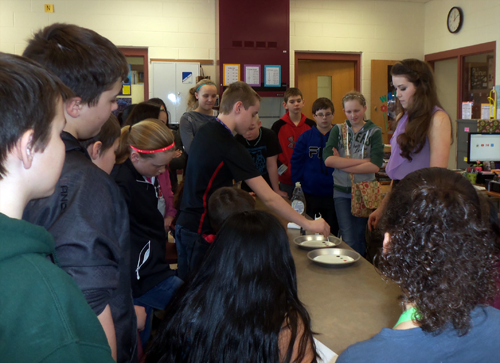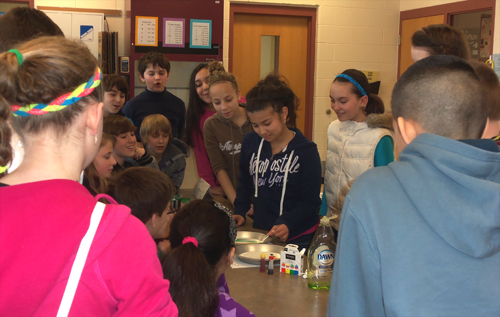Bringing Science Magic to the Classroom
A magic milk rainbow may be all about what's happening at the surface level between milk and soap, but when kids create the magic, the learning excitement is palpable. For Lily Arendt, hands-on science activities are a great way to help kids uncover the magic of science. We couldn't agree more!

For Lily Arendt, a biology student at DePaul University in Chicago and a participant on the Miss America beauty pageant circuit, engaging students, especially girls, with science and inspiring them to ask science questions and experiment to find answers is an issue she's putting front and center both as her pageant platform and with students in her hometown.
Lily recently took the Science Buddies Make a Milk Rainbow activity, part of the brand new Science Buddies Activities area, into fifth and sixth grade classrooms in Green Bay, Wisconsin to bring cool chemistry into the classroom and give students a chance to get hands-on with some awe-inspiring science.
After spending time with students in four different classes, Lily says the kids' enthusiastic response to the milk rainbow experiment was unanimous. "I was thrilled to see that all four classes were equally excited about the experiment!"
The project involves the reaction between food dye, dish soap, and milk. With these simple ingredients, four individual drops of food coloring can be mixed and swirled into a rainbow or a spin-art-style display by touching a cotton-tipped swab dipped in soap to the surface of the milk. The science of surface tension and surfactants helps demystify what is going on, but it looks a lot like magic when the colors begin to move away from the swab even though they were not touched. This is a colorful science experiment that is sure to bring oohs and ahhs.
Lily says she, too, was wowed when she first tried out the milk rainbow experiment. "I was just as impressed with the movement of the food coloring as the kids were! I definitely believe this experiment has an element of science 'magic' that all ages would enjoy."
In the classroom activity, Lily helped the students set up the demonstration, and then she stepped back, letting the kids get hands on to see what happened as they, not a teacher, touched the swab to the surface of the milk. A swab with nothing on it caused the milk to behave one way. But a swab dipped in soap caused something entirely different to happen! This kind of active learning can be incredibly empowering for students who think science is something that happens in a lab somewhere by real scientists.
Supplementing science education with opportunities for active learning is what Science Buddies project ideas and now science activities are all about. With great ideas and blueprints for science experiments scaled for independent study or fun family weekends, Science Buddies is helping students, teachers, and parents take an active role in science exploration at home or at school.
It's a perspective on science that Lily shares.
"After taking many lecture-based science classes throughout my education," says Lily, "I've realized how disengaging it can be to simply listen to someone tell you the cool things about science. The thing I love about science is that it does have that 'wow' factor, and students, especially in elementary and middle school, should have the opportunity to experience science in their own way! Doing a hands-on experiment may just be what it takes to ignite that spark between a student and a love for science."
Not only did they enjoy the chemistry experiment, but the fifth and sixth grade students Lily worked with were excited to go home and share the experiment with friends and family. In re-telling or re-creating the experiment at home, they continue to process and absorb what they learned, articulate it, and pass on the fun.
In the classroom, Lily spent time talking with students about science careers, showed them how the Topic Selection Wizard works, and looked at sample Project Ideas that came up as "recommendations" for an individual student.
"When I discovered the Topic Selection Wizard on the website, I knew I needed to share it with the students," says Lily. "I wish I had had this resource when I was doing my elementary and middle school science experiments and even when I was first looking into a science career!"
A popular tool on the Science Buddies website, the Topic Selection Wizard helps match students with science projects in which they might be especially interested—based on their responses to a simple questionnaire. Many times, students uncover a perfect project using the Topic Selection Wizard that they might not have discovered by just browsing the directory of projects.
"The school I visited does have a wonderful science fair every year," says Lily, "and scrolling through the recommended projects, I know there were many experiments that caught the students' eyes."
For Lily, time spent in the classroom helping connect kids with the "magic" and wonder of science is time well spent. Lily says she has always been interested in science. Even as a kid, she says she enjoyed both doctor and dentists appointments because the doctors would explain the science behind what they were doing.
Lily also fondly remembers her 4th grade science fair project. "It was called 'Which will float: the ball or the boat?'," says Lily. "I had shaped multicolored clay into both a round ball and a concave boat shape and placed them in a tub of water to see what they would do. I definitely wish I had had Science Buddies as a tool when I was in 4th grade, but I remember demonstrating the experiment to my friends and loving the fact that I had come up with the experiment all on my own!"
Her childhood fascination with science blossomed into career goals when she took AP biology in high school. Today, Lily is studying biology at DePaul while working to promote science, technology, engineering, and math (STEM) education as part of her pageant platform.
"My pageant platform is called 'Women in Science: Exceeding the Boiling point,' and I chose this title because that is exactly what I want to encourage young women to do—to exceed the expectations placed on them in the sciences! Currently in the United States, only 25% of the available STEM careers are filled by women, and in a country where science and technology is valued so highly, that is truly a shame. I believe an interest in science starts at a young age, and young women need female role models to demonstrate to them that it's okay to love the sciences and that it is possible to become a confident, successful woman with a science career! I am so happy to have found Science Buddies, and I look forward to using it as a resource to encourage young women to pursue the sciences."
With up-and-coming scientists like Lily speaking out to girls and going into classrooms to show students that science is there, within reach, and full of magic and fun, there is hope for more and more students to embrace the sciences. Science Buddies is proud to support the process and to provide materials that help mentors, volunteers, parents, and teachers bring science to life for students—just like Lily did for students in Green Bay.

See our overview of the new Science Buddies Science Activities area.
Categories:
You Might Also Enjoy These Related Posts:
- Star Wars Projects for May the 4th Be With You Science
- Spring Science Projects: 26 Science Experiments for Spring
- 5 STEM Activities with Marshmallow Peeps
- 6 Picks for St. Patrick's Day STEM
- 12 STEM Activities for Lunar New Year - Year of the Dragon Science
- Winter Science Projects, Lessons, and STEM Activities
- Make Some New Year's Noise with Science Projects!
- Holiday STEM Projects to Make and Give









